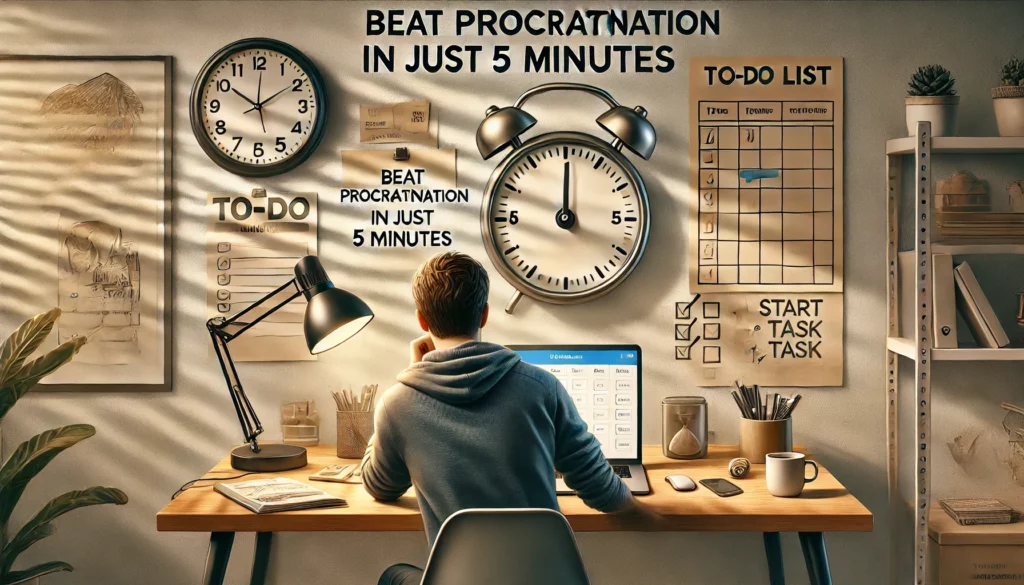Procrastination is one of the most common—and frustrating—barriers to productivity. You know what needs to be done, but instead, you catch yourself doing anything but that task. Whether it’s scrolling through your phone, watching a video, or tidying up your space for the fifth time, the result is the same: nothing meaningful gets done.
Here’s the surprising truth: you don’t need to wait for motivation, inspiration, or a perfect moment. You don’t even need an entire afternoon free. All it takes to beat procrastination is five minutes.
This guide will show you why five minutes is all you need, and how to turn that tiny window into a powerful habit that helps you take consistent action—even when you don’t feel like it.
Why We Procrastinate
Procrastination isn’t about laziness. It’s usually your brain avoiding discomfort. When a task feels too big, boring, or difficult, your mind naturally looks for something more pleasant or easier to do instead.
Here are some common reasons we procrastinate—and the mental traps they create:
- The task feels overwhelming, so we avoid it completely
- We’re afraid of failing, so we delay getting started
- There’s no immediate deadline, so we tell ourselves we’ll do it “later”
- We don’t feel motivated, so we wait to be in the right mood
The key to beating procrastination is not trying to eliminate these feelings—but working around them by starting before your brain has time to resist.
That’s where the five-minute rule comes in.
The Five-Minute Rule: Your Shortcut to Action
The five-minute rule is incredibly simple but surprisingly effective. It works because it makes starting a task feel easy, which is often the hardest part.
Here’s how it works:
- Choose a task you’ve been avoiding
- Commit to doing it for just five minutes
- After five minutes, you’re free to stop—but chances are, you won’t want to
Why does this work so well?
- It reduces the pressure by lowering the commitment
- It helps you overcome the “all or nothing” mindset
- It builds momentum—once you begin, continuing feels natural
Instead of telling yourself, “I have to finish this entire project,” you tell yourself, “I’m just going to start.” And starting is the hardest part. Once you’re in motion, the rest usually follows.
Other Quick Techniques to Beat Procrastination in Five Minutes or Less
1. Try the Two-Minute Rule
If five minutes still feels like too much, go even smaller. The two-minute rule—popularized by James Clear in Atomic Habits—is about doing something so small, it’s impossible to say no.
Examples:
- Do one push-up instead of a full workout
- Read one paragraph instead of a whole chapter
- Clean one corner of your desk instead of the entire office
The beauty of this method is that it removes resistance. Once you start, you often end up doing much more.
2. Use the Five-Second Rule to Break Hesitation
Mel Robbins introduced a simple method to override procrastination: when you feel hesitation creeping in, count down from five and act before your brain talks you out of it.
You simply:
- Count down: 5-4-3-2-1
- Immediately move—stand up, open your laptop, write the first word
This technique works because it interrupts your internal dialogue and replaces overthinking with immediate action.
3. Create Micro-Wins
Instead of focusing on the entire task, shift your attention to small, quick victories.
Examples:
- Write a single sentence of your report
- Send one short follow-up email
- Review one slide of your presentation
These micro-wins are powerful. They give you a sense of progress and show your brain that action leads to results.
4. Use a Five-Minute Countdown Challenge
Gamifying a task can make it more engaging and less intimidating. Set a timer for five minutes and challenge yourself to get as much done as possible before the timer ends.
The time pressure turns the task into a mini game. Often, when the timer goes off, you’re so focused that you’ll keep going.
This technique works especially well with tasks you’ve been putting off due to boredom or low urgency.
5. Bundle the Task with Something You Enjoy
If you’re struggling to start because the task feels boring or unpleasant, pair it with something you look forward to. This approach is called “temptation bundling.”
Examples:
- Only listen to your favorite playlist while working on admin tasks
- Light a candle or make a cup of tea before starting your work
- Watch a show only while folding laundry
By creating a positive emotional association, you make the task easier to start and more enjoyable to complete.
How to Make the Five-Minute Rule a Daily Habit
Start Your Day with a Five-Minute Action
Begin your morning with a quick task that gives you a small win. It sets a positive tone for the rest of your day.
Examples:
- Write the first sentence of an article
- Stretch for five minutes
- Review one to-do item
When your day starts with movement, it’s easier to keep moving.
Use “If-Then” Planning
Anticipate procrastination and plan a simple response in advance. This reduces decision fatigue and helps you act automatically.
Examples:
- If I feel like avoiding this task, then I’ll do five minutes of it first
- If I catch myself reaching for my phone, then I’ll set a five-minute timer before checking it
These statements create a structure that supports consistency.
Reward Yourself After Five Minutes
Reinforce the habit by giving yourself a small reward when you follow through.
Examples:
- After five minutes of focused work, take a short walk
- After tackling a difficult task, enjoy a snack or a break
- After your five-minute win, cross it off your list to feel progress
These rewards help your brain associate taking action with something positive, making it easier to repeat the behavior.
Final Thought: Five Minutes Can Change Everything
Most people overestimate what they need to get started and underestimate how powerful a small action can be. You don’t need to feel ready. You don’t need to wait for motivation. You just need to start—for five minutes.
Once you do, something shifts. Momentum builds. Confidence grows. And what once felt overwhelming becomes manageable—even energizing.
If you’re stuck, start small. Take five minutes. Let it be messy. Let it be short. Let it be enough to get going.
Because once you’ve started, you’re no longer procrastinating. You’re moving. You’re building. You’re winning.
Gabriel Silva is the founder of Cursos e Soluções, a blog dedicated to personal growth, habit change, and self-discipline. Passionate about self-development and productivity, he shares practical, research-backed strategies to help people achieve their goals. He believes that small, consistent changes can lead to significant transformations over time and is committed to providing content that empowers both personal and professional success.







